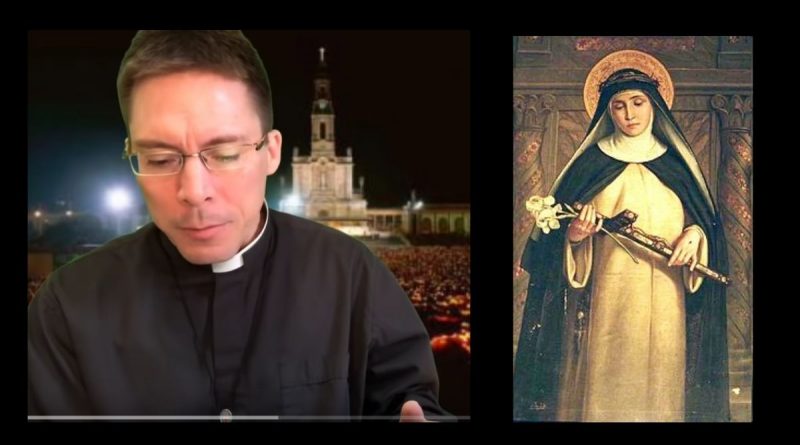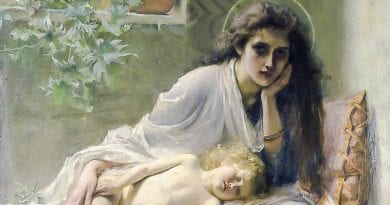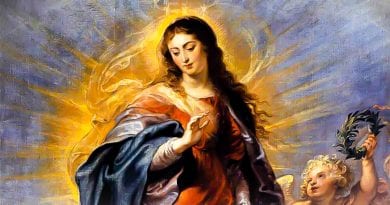Forgiveness of Sin During Chastisement & St. Catherine of Siena – Fr. Mark Goring
April 29th is the memorial of St. Catherine of Siena.
She is a saint, a mystic, and a doctor of the Church, as well as a patroness of Italy and of Europe.
Who was she, and why is her life so significant?
Here are 8 things to know and share . . .
While living at home, she confirmed her vow of virginity made privately when she was still an adolescent and dedicated herself to prayer, penance and works of charity, especially for the benefit of the sick.
Note from her birth and death dates that she only lived to be 33 years old. Nevertheless, a lot happened during her life!
2. What happened after St. Catherine entered religious life?
Quite a number of things. St. Catherine was sought out as a spiritual director, and she played a role in ending the Avignon papacy (when the pope, though still the bishop of Rome, actually lived in Avignon, France).
Pope Benedict explains:
When the fame of her holiness spread, she became the protagonist of an intense activity of spiritual guidance for people from every walk of life: nobles and politicians, artists and ordinary people, consecrated men and women and religious, including Pope Gregory XI who was living at Avignon in that period and whom she energetically and effectively urged to return to Rome.
She travelled widely to press for the internal reform of the Church and to foster peace among the States.
It was also for this reason that Venerable Pope John Paul II chose to declare her Co-Patroness of Europe: may the Old Continent never forget the Christian roots that are at the origin of its progress and continue to draw from the Gospel the fundamental values that assure justice and harmony.
3. Did she face opposition in her lifetime?
Pope Benedict explains:
Like many of the saints, Catherine knew great suffering.
Some even thought that they should not trust her, to the point that in 1374, six years before her death, the General Chapter of the Dominicans summoned her to Florence to interrogate her.
They appointed Raymund of Capua, a learned and humble Friar and a future Master General of the Order, as her spiritual guide.
Having become her confessor and also her “spiritual son”, he wrote a first complete biography of the Saint.
4. How has her legacy developed over time?
Pope Benedict explains:
She was canonized in 1461.
The teaching of Catherine, who learned to read with difficulty and learned to write in adulthood, is contained in the Dialogue of Divine Providence or Libro della Divina Dottrina, a masterpiece of spiritual literature, in her Epistolario and in the collection of her Prayers.
Her teaching is endowed with such excellence that in 1970 the Servant of God Paul VI declared her a Doctor of the Church, a title that was added to those of Co-Patroness of the City of Rome — at the wish of Bl. Pius IX — and of Patroness of Italy — in accordance with the decision of Venerable Pius XII.
5. St. Catherine reported experiencing a “mystical marriage” with Jesus. What was this?
Pope Benedict explains:
In a vision that was ever present in Catherine’s heart and mind Our Lady presented her to Jesus who gave her a splendid ring, saying to her:
“I, your Creator and Saviour, espouse you in the faith, that you will keep ever pure until you celebrate your eternal nuptials with me in Heaven” (Bl. Raimondo da Capua, S. Caterina da Siena, Legenda maior, n. 115, Siena 1998).
This ring was visible to her alone.
In this extraordinary episode we see the vital centre of Catherine’s religious sense, and of all authentic spirituality: Christocentrism.
For her Christ was like the spouse with whom a relationship of intimacy, communion and faithfulness exists; he was the best beloved whom she loved above any other good.
This profound union with the Lord is illustrated by another episode in the life of this outstanding mystic: the exchange of hearts.
According to Raymond of Capua who passed on the confidences Catherine received, the Lord Jesus appeared to her “holding in his holy hands a human heart, bright red and shining”. He opened her side and put the heart within her saying:
“Dearest daughter, as I took your heart away from you the other day, now, you see, I am giving you mine, so that you can go on living with it for ever” (ibid.).
Catherine truly lived St. Paul’s words, “It is no longer I who live, but Christ who lives in me” (Gal 2:20).





